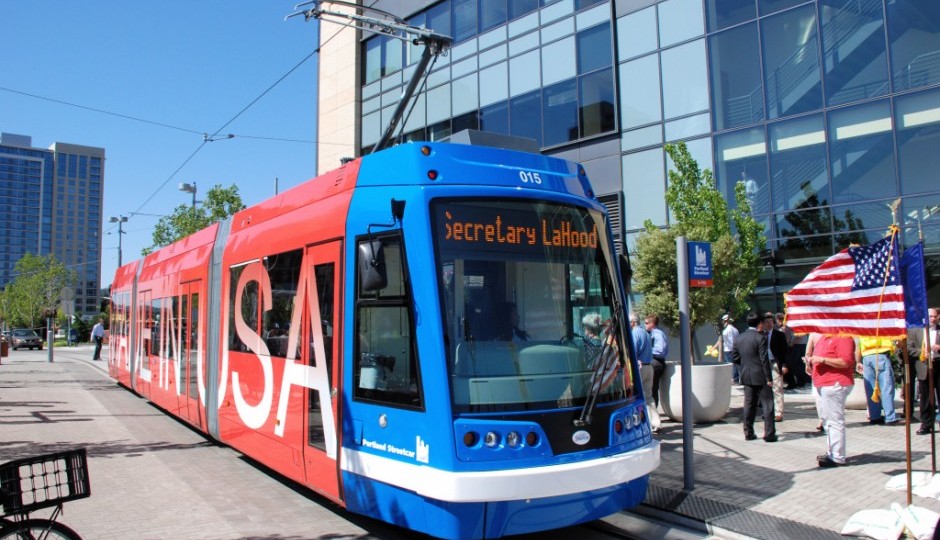Sleek, Modern Trolleys Coming to Philly

Modern, articulating trolleys, like this one in Portland, Oregon, are coming to Philadelphia. | Photo by Steve Morgan. Licensed under CC BY-SA 3.0.
Philadelphia has the largest trolley system in the nation, a title it’s held since the 1970s. But the old-school tanks climbing up and down city streets look like relics from our parents’ (or grandparents’) generation. Trolleys along Baltimore Avenue in the Southwest are early-80s Kawasaki models; on Girard Avenue, the trolleys are actually reconditioned from the ‘40s.
In a few years, though, that’s going to change in a big way.
In an interview with Citified, SEPTA’s director of strategic planning and analysis, Byron Comati, said that a massive trolley fleet renovation is on the horizon. “Once the Key system is done, the next biggie that has complications will be trolley modernization,” Comati said. “It’s a transformational project. You do this once in a generation.”
If the overhaul follows script, the new trolley system will be hardly recognizable. It will feature sleeker, faster and handicap-accessible streetcars. Gone will be the entry and exit points that require stepping up and down. Instead, passengers will have floor-level boarding onto the streetcars, which will require substantial alterations to streetscape infrastructure. For example, the 34 line in Southwest Philly runs alongside parked cars and makes stops at every block. Creating level-boarding platforms and redesigning intersections will be a major undertaking by SETPA, PennDOT and the Streets Department.
Assuming all of that is worked out, expect a smoother experience. “The service will be faster because of level boarding,” says Comati. “No steps, no up-and-down—your dwell time at a station stop is going to drop, which means the speed of the trip will go up.” The changes sound a lot like transforming SEPTA’s trolley system into something akin to Portland’s refashioned “Loop,” which has been immensely successful since launching in 2012. It features level boarding and has over 15,000 riders each day.
According to Comati, funds have been allocated in the capital program to buy 100-plus new trolleys over the next few years, at $2.5 to $3 million apiece. “We are going through the early stages of the procurement phase,” Comati says, which includes reaching out to manufacturers across the world for quotes. “In the next two to three years, we will be procuring state-of-the-art, articulated, low-floor, easy-access 80-foot vehicles.”
Aside from refashioning the trolley cars, expect few immediate changes to the system. SEPTA is still considering reopening the old 23 trolley route—which ran between Chestnut Hill and South Philadelphia via Germantown Avenue and 11th and 12th Streets—perhaps in a truncated form. Otherwise, the routes and lines should stay the same, according to Comati.
Nationally, streetcars had been enjoying something of a renaissance. Call it the hipsterization of public transportation, if you will, but over the last decade, this once-vintage transit mode has been exploding. And the boom hasn’t been cheap. Brand-new lines are underway in Tucson ($196 million) and Dallas ($800 million). More than 20 cities have upgraded their existing light-rail infrastructure in the past few years, including Portland ($148 million), Milwaukee ($124 million) and Salt Lake ($56 million). And nationwide, light-rail ridership increased by 3.6 percent in 2014, more than any other type of public transit.
But there are signs the “streetcar revival” (as U.S. Transportation Secretary Ray LaHood once proclaimed it) is petering out. The laudatory headlines (example: the New York Post in 2013, “Streetcars Find New Life Through Urban Revival Plans”) have quickly reversed course and now feature seeds of doubt (the New York Times yesterday: “Streetcar Revival Is Wavering in Some Cities”). The fanfare over streetcars may turn out to be a short-lived, boom-to-bust fad in some cities.
Last year, San Antonio’s planned streetcar line—with an estimated cost of over $90 million—was scrapped entirely. The long-anticipated system in Washington D.C., which proponents said could generate $8 billion of economic development in 10 years, has been scaled back to half the original size. And the County Board of Arlington, Virginia, voted to cancel the construction of its 7.4-miles line and offered no Plan B for new transit in its place.
Unlike those cities, Philadelphia already has a huge trolley infrastructure which includes, critically, the West Philly and Center City tunnels, which enable trolleys to avoid street-level obstructions like double-parked delivery vehicles and the like.